“Illuminating the Medieval Hunt” at the Morgan
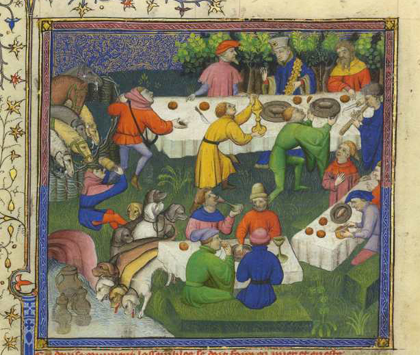
The Morgan’s copy is thought to have been commissioned by Philip the Bold’s son, John the Fearless (1371–1419), who presumably inherited his father’s manuscript and had copies made. During the late Fifteenth Century, it was owned by King Ferdinand II of Aragón and Queen Isabella of Castile, who added to it their full-page coat of arms. Of the 46 known surviving copies of the manuscript, the Morgan’s is one of the two finest extant examples; the other, in the Bibliothèque nationale de France, was made at the same time and contains the same cycle of 87 miniatures.
Le Livre de la chasse is divided into four books — on gentle and wild beasts; on the nature of dogs and their care; on hunting in general and hunting with dogs; and on hunting with traps, snares and cross bow. Written in French, the work was enormously popular throughout Europe and England, where it was translated under the title Master of Game.
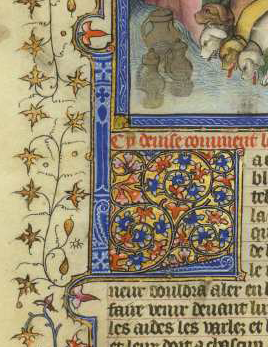 The manscript is richly decorated and the miniatures are unique windows to observed medieval life. The manuscript is from a famous court. This was a historically critical time of rapid cultural evolution following the black death of the previous century. If you are unable to make it to the Morgan to see this book, a large selection of images from another copy of this 15th century manuscript is available here.
The manscript is richly decorated and the miniatures are unique windows to observed medieval life. The manuscript is from a famous court. This was a historically critical time of rapid cultural evolution following the black death of the previous century. If you are unable to make it to the Morgan to see this book, a large selection of images from another copy of this 15th century manuscript is available here.
April 2, 2008 Comments Off on “Illuminating the Medieval Hunt” at the Morgan
Foundation Musick’s Monument
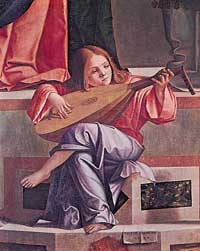 Sometimes something is just cool. FOUNDATION MUSICK’S MONUMENT is cool. Here is how they describe themselves:
Sometimes something is just cool. FOUNDATION MUSICK’S MONUMENT is cool. Here is how they describe themselves:
The Stichting Musick’s Monument produces Historical Art Productions, partly in association with scholars from the Chair of Humanities of the University of Amsterdam (UvA). Pictures, music and text are integrated: You will hear music from the same period and the same area of origin as the visual materials; these are supplemented with explanatory text. From this combination evolves something like a Gesamtkunstwerk (a total work of art), a complete new way of digital art presentation.
This page has a great video. Be patient. Some things on this site take quite a bit of time to load but it’s worth the wait.
March 31, 2008 Comments Off on Foundation Musick’s Monument
The Museum of Biblical Art in New York City Exhibiting 50 Medieval artworks in “Realms of Faith: Medieval Art from the Walters Art Museum”
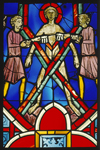 The Walters Art Museum in Baltimore has one of the premiere collections of Medieval Art in the United States. Fifty works from this splendid collection are on exhibit in the Museum of Biblical Art in New York City (MOBIA) through July 13 of 2008. From the Home News Tribune:
The Walters Art Museum in Baltimore has one of the premiere collections of Medieval Art in the United States. Fifty works from this splendid collection are on exhibit in the Museum of Biblical Art in New York City (MOBIA) through July 13 of 2008. From the Home News Tribune:
In this exhibition, a selection of both rarely seen and well-known pieces, from geographic origins that stretch from Spain to Turkey and Russia to North Africa, provide the viewer with an introduction to the great diversity of medieval art forms and styles.
Delving into the art, history and religion of the Middle Ages, visitors will discover the ritual function of religious objects and the rich symbolic meanings the artworks had for their medieval users. With an array of public programs that include a family-friendly Medieval Fair, “Realms of Faith” is designed to open a window onto the past.
The MOBIA web site (link above) offers a beautiful on-line slide show of some of the items in this featured exhibit. From MOBIA:
Unlike today’s world, in which we commonly insert a divide between the sacred and secular realms, during the medieval period Christians sought biblical connections to all aspects of their everyday lives. Artists in the western European nations and eastern Byzantine Empire alike expressed their personal faith and satisfied the desires of their patrons by creating objects that served as “crafted confessions” of their beliefs. Supplemented by books and loose leaves from the collection of the American Bible Society, these declarations of devotion demonstrate the inspirational adaptability of Christian ideas, which provided a catalyst for the manufacture of medieval artworks. In a museum setting, it is easy to forget that these objects were not made to be set within glass cages. They were vital components of the living faiths of the people who used them. The impact these artworks exerted is examined in three arenas of medieval life: the Realm of Liturgical Celebration, the Realm of Private Devotion, and the Realm of Domestic Life.
This sounds like a great show but if you can’t get there make sure and visit MOBIA’s site and Walters Museum site to see the art on-line.
March 15, 2008 Comments Off on The Museum of Biblical Art in New York City Exhibiting 50 Medieval artworks in “Realms of Faith: Medieval Art from the Walters Art Museum”
“A Tale of Two Manuscripts Reunited” – 14th Century Medieval Love Poem
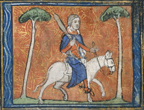 Two 14th Century love poems have been reunited at the University of Chicago. From their press release:
Two 14th Century love poems have been reunited at the University of Chicago. From their press release:
The University of Chicago Library acquired a 14th-century manuscript of “Le Roman de la Rose,” or “The Romance of the Rose” – which scholars have referred to as the most popular medieval love poem – reuniting it after a 100-year separation with a manuscript with which it was previously bound.
In 1907, the manuscript of “Le Roman de la Rose” was separated from that of “Le Jeu des Echecs Moralise,” or “The Moralized Game of Chess,” which the University of Chicago Library acquired in 1931.
Both manuscripts will be on display in the Library’s Special Collections Research Center at 1100 E. 57th St., beginning Feb. 14 as part of the exhibition: “Romance and Chess: A Tale of Two Manuscripts Reunited.” Opening remarks will be made at 12:30 p.m. at the Valentine’s Day opening by Alice Schreyer, Director of the Special Collections Research Center; Daisy Delogu, Assistant Professor of Romance Languages and Literature; and Aden Kumler, Assistant Professor of Medieval Art and Architecture at the University of Chicago. The event is free and open to the public. The exhibit will run through March 14.
“Bringing the two parts of this book back together will enable discoveries that would not be possible if they remained apart,” Schreyer said.
Added Delogu, “This ‘Le Roman de la Rose’ manuscript has extraordinary potential to enrich research and teaching opportunities here at Chicago, and will be of interest to scholars of manuscript culture and literary studies worldwide. ‘Le Roman de la Rose’ is arguably the single-most influential vernacular text of the late French Middle Ages.”
These beautiful manuscripts are currently on display at the University of Chicago. You can learn more about the history of these 14th century poems at the University of Chicago Library web site.
March 4, 2008 Comments Off on “A Tale of Two Manuscripts Reunited” – 14th Century Medieval Love Poem
The Devil’s Bible or Codex Gigas Goes on Display September 20th
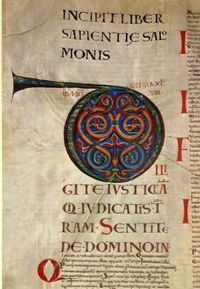 The Devil’s Bible or Codex Gigas is the biggest medieval book in the world. It has a fascinating history and legend. It will be on public display for the first time in many years at the National Library of Sweden on September 20th. From The Prague Post:
The Devil’s Bible or Codex Gigas is the biggest medieval book in the world. It has a fascinating history and legend. It will be on public display for the first time in many years at the National Library of Sweden on September 20th. From The Prague Post:
…legend holds that a monk was sentenced to be buried alive for a breach in Benedictine conduct. In order to forgo his punishment, he agreed to make the most magnificent book the world had ever seen in honor of his brotherhood. The catch was that he was given just one night to complete this Herculean task.
Around midnight, the monk realized he would not be able to finish by daylight, so he invoked the devil to help him, selling his soul in the process. As a tribute to his helper, the monk included a quirky image of the devil within the manuscript, thus giving the book its nickname.
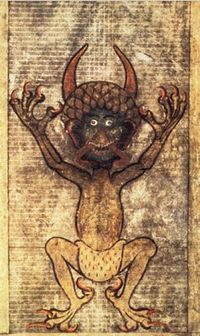 This medieval illuminated manuscript is extremely important. It’s size alone makes it unique. From The Prague Post:
This medieval illuminated manuscript is extremely important. It’s size alone makes it unique. From The Prague Post:
Made of the skins of about 160 animals — some say donkeys, others say calves — the manuscript measures a king-size 90 x 50 x 22 centimeters (roughly 36 x 20 x 9 inches) and weighs 75 kilos (165 pounds), requiring two people to lift it.
 It was first mentioned towards the end of the 13th century and probably dates from the early years of that century. Analysis of the writing style have led to the hypothesis that the book is the work of an individual scribe.
However, what is most important about this phenomenal work is the content. From The Prague Post:
The leather parchment pages contain both the Old and New Testaments of the Bible in pre-Vulgate Latin and much more: a Penitential (a priest’s manual of sins and suitable penance); Isidore of Seville’s Etymologiae, a 20-volume encyclopedia from the seventh century; Josephus’ Antiquities of the Jews; a necrology of the Podlažice monastery as well as a list of all the living monks in Podlažice; and numerous texts of mystical incantations for everything from curing illnesses to catching thieves.
Individuals swayed by mystical thinking believe the incantations in the manuscript have real power and, when the Devil’s Bible was displayed many years ago at the National Museum of Sweden, it was attacked. Thus, considerable security and secrecy surround the current display. For more information on this beautifully illuminated manuscript, visit the National Library of Sweden website.
[tags]codex gigas, devil’s bible, national library of sweden, illuminated manscript, medieval manuscript, medieval scribe[/tags]
September 13, 2007 Comments Off on The Devil’s Bible or Codex Gigas Goes on Display September 20th

